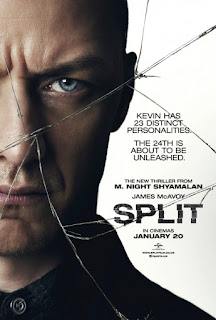By now, it’s pretty much a sure thing. When I go to an M. Night Shyamalan film, I’m going to enjoy it. I’m going to get odd characters, interesting ideas, an intriguing setting, surprises, and a doozy of a climax, as well as a deeper meaning to reflect upon for years to come.
Split, the next jewel in the underappreciated director’s oeuvre, delivers all these gifts. The film also proves Shyamalan’s strong awareness of the filmgoer’s role in the story. This time, he invites the viewer into the world of antagonist Kevin Wendell Crumb (James McAvoy), who has a diagnosis of dissociative identity disorder (DID)—they used to call it multiple personality disorder. Crumb imprisons three teenage girls for reasons that gradually come to the fore. It’s a fun story that keeps the viewer locked in for the entirety of the film, but also, in typical Shyamalan fashion, it’s a tribute to those who face trials. This time, he takes on the broken and the abused.
Beauties and the Beast
The inciting incident happens a mere five minutes into the film: Dennis (one of Crumb’s 23 personalities) abducts Marcia and Claire, along with chief protagonist Casey, a third girl he hadn’t anticipated. He brings them to his hideout, then his other personalities, which are aware of each other’s existence, begin to surface. Marcia and Claire try traditional escape routes, whereas the more pensive Casey attempts to manipulate the personalities. The scenes shift between the hideout, flashbacks to Casey’s childhood with her father and uncle, and psychologist Dr. Fletcher’s interactions with Berry (a fashion designer personality of Crumb’s).
Much of the film’s tension stems from a villain the personalities refer to as “the Beast”, who is supposedly coming for the girls. Shyamalan keeps the viewer guessing: Is the Beast a figment of Crumb’s imagination? Another person? Some kind of superhuman creature? Or is it the antagonist’s 24th personality that has yet to surface?
The Mind-Body Connection
The film introduces documentation of DID sufferers altering their body chemistry based on which personality is occupying them. For instance, one personality might need insulin whereas others don’t, or one personality might have a different cholesterol level than the others. Shyamalan takes this mind-body connection to the next level, suggesting that Crumb might be able to use the power of his fragmented mind to achieve exceptional physical abilities.
Dr Fletcher doesn’t give the viewer much reassurance. She argues that the Beast is an impossibility, but also posits that those with DID could be more physically evolved humans due to their ability to manipulate their bodies. It’s like a souped-up version of the philosophy that many of these self-help gurus espouse: if you think hard enough about some state of being, you can achieve it.
A Smash Split
One of the things I’ve always admired about Ozzy Osbourne was his willingness to step back and let his lead guitarists shine. Similarly, Shyamalan, despite his drive to impart a lesson and control his plot, lets James McAvoy do his thing and thus captures a truly riveting performance.
What a treat it is to watch McAvoy’s facial expressions and vocal nuances as the camera lingers on him. Especially enjoyable are those pivotal scenes during which we witness, sometimes gradually and sometimes quickly, a character shift.
McAvoy’s versatility is evident in Dennis and Patricia, the two vastly different “difficult” personalities that have enlisted the others in their “philosophy of the Beast”. The most entertaining personality comes in the form of nine-year-old boy Hedwig. You know he’s going to be fun the moment he utters his first words in the film: “My name’s Hedwig. I have red socks.” Watch for Hedwig’s maniacal dance to Snails’ “Frogbass”.
Though his portrayal of DID is likely way off base, Shyamalan uses our Hollywood-instilled preconceptions about the mental illness to create a compelling story.
Remember that Shyamalan, the conscientious director, may be challenging you, the willing participant in this tale, to fill in the blanks. So as you settle into his dark world, look for the light that may just shine through. – Douglas J. Ogurek *****


No comments:
Post a Comment